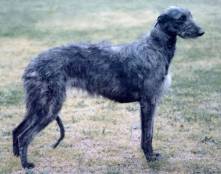Deerhound and Irish Wolfhound
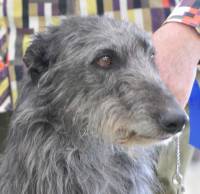 DeerHound
DeerHound
So many stories of fact and fable surround the history of these two related Gazehounds or Sight Hounds, the accuracy of their exact background has become lost in the mists of time. For these breeds are as old as the first civilizations of Scotland and Ireland respectively. It is fair to say the British Isles would not have become established in the first instance had it not been for the assistance of these magnificent, majestic hunting dogs.
History of the Irish Wolfhound and the Deerhound
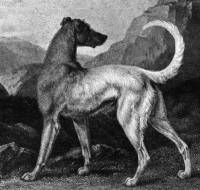 Irish Wolfhound 1803
Irish Wolfhound 1803
When the Celts first arrived in Britain decades before Christ was born, it was overrun with wild deer and wolves. So large hunting dogs were required to hunt prey from which they derived their respective names. Although they may look somewhat alike, the Deerhound required speed, power and endurance to pull down a deer for the hunter to kill; whereby the more heavily built Irish Wolfhound was required to kill wolves.
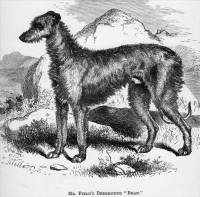 Deerhound 1867
Deerhound 1867
Following the birth of Christ, the Vikings who invaded both Scotland and Ireland, presumably interbred the two strains both for sport and for gifts to various kings. During the next two millennia, Britain became much more populated and wars were fought. Never-the-less, hunting expeditions firstly in virgin country and then on large estates, remained a popular pastime. So the large hound with its rough coat became legendary in both Scotland and Ireland.
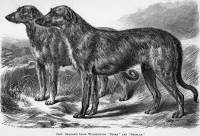 Irish Wolfhounds 1866
Irish Wolfhounds 1866
' I am disposed to affirm that the old Irish Wolfhound and the Highland Deerhound are not only intimately allied in form and nature, but they are two strains of an identical breed, altered only in size and environment"[4]
 Scottish Deerhounds
Scottish Deerhounds
As the centuries rolled by hunting with dogs on large estates was no longer in vogue. So these giant hounds outlived their usefulness. But by the late 1800's the pure breed dog scene began taking centre stage. Enthusiasts of both breeds resurrected the lines they believed remained pure and so we have the (Scottish) Deerhound and Irish Wolfhound we know today.
History of Deerhounds and Irish Wolfhounds in Australia
 Deerhound in Australia Large hunting dogs have been present in Australia since the earliest settlements. They were used in conjunction with Greyhounds to rid settlers' properties of our indigenous quarry, the kangaroo and dingo. As there were no formal registration systems in Australia until the 1880's, whether these 'hunting dogs' were 'Deerhounds' or Irish Wolfhounds is unclear. At that time, crosses between these 'hunting dogs' and Greyhounds regularly occurred to make up an unrecognised breed, the Kangaroo Dog[5].
Deerhound in Australia Large hunting dogs have been present in Australia since the earliest settlements. They were used in conjunction with Greyhounds to rid settlers' properties of our indigenous quarry, the kangaroo and dingo. As there were no formal registration systems in Australia until the 1880's, whether these 'hunting dogs' were 'Deerhounds' or Irish Wolfhounds is unclear. At that time, crosses between these 'hunting dogs' and Greyhounds regularly occurred to make up an unrecognised breed, the Kangaroo Dog[5].
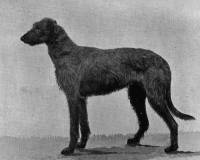 Deerhound 'Newton Spey' Imp into Australia 1895)
Deerhound 'Newton Spey' Imp into Australia 1895)
The first 3 pure breed Deerhounds were exhibited at the first VP&KC Show in 1881, with another 10 being imported by 1898, including Newton Spey (pictured). During the next decade, another 16 registered Deerhounds were bred here[1].
An Irish Wolfhound named 'Jasper' owned by Mr J H Clough of Collins Street West was entered in the first exhibition of 'Sporting and Other Dogs' held at the Exhibition Buildings, Melbourne on April 7 - 8 1864[3]. But the first documented arrival of a pure breed Irish Wolfhound was not until 1928. It was recorded that importer was so worried about crosses that no bitches were sold! So it was not until the 1970's when registered imports arrived that the Irish Wolfhound became established in Australia as a pure breed[2].
Comparison between the Deerhound and Irish Wolfhound
These breeds have a common background, are similarly coloured and resemble large rough coated greyhounds. But as the Irish Wolfhound is more substantially built than the elegant Deerhound, an in-depth comparison of these two breeds is presented below.
| Deerhound | Irish Wolfhound | |
|---|---|---|
| Type | A combination of speed, power and endurance | Of great size, showing power, activity and symmetry |
|
|
 Irish Wolfhound Irish Wolfhound |
|
| Height | Males Height minimum 30" (76 cms) Females minimum 28" (71 cms) | Desired height averaging 32" - 34" (81 - 86 cms) Males minimum 31" (79 cm); Females minimum 28" (71 cms) |
| Weight | Males about 100 lbs (45.5 kgs) Females about 80 pounds (36.5 kgs) | Males minimum 120 lbs (54.5kgs) Females minimum 90 pounds (40.5 kgs) |
| Colour | Self-coloured dark blue-grey or lighter grey, yellow, sandy-red or red fawn with black points or brindle. White on the chest or toes or a slight white tip on the tail permissible. | Grey, brindle, red, black pure white, fawn as well as all the allowable colours of the Deerhound |
| Coat | Shaggy, ragged and close-lying only 3-4" (8-10cms) long. So it is not overcoated. Instead it should be hard or crisp to touch except on the head, breast and belly. | Hair that is rough and hard on the body, legs and head. The hair over the eyes and beard is especially wiry. |
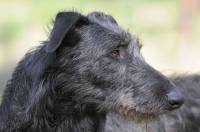 Deerhound Deerhound |
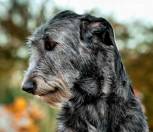 Irish Wolfhound Irish Wolfhound |
|
| Head | The head tapers from ears to muzzle which curves slightly downwards with no stop between, to the black nose. Moderately long, silky hair covers the skull and extends to the moustache. | The head is long with the skull not too broad and a slight stop caused by the frontal bones of the forehead, and the muzzle moderately pointed. The skull is covered with wiry hair which extends to the beard. |
| Eyes | Dark with black rims and a far away expression | Dark |
| Ears | Small, black or dark-coloured, set on high and folded back. Can become semi-erect when excited, but never erect or heavy and completely dropped. | Rose-shaped ears |
| Mouth | Scissor bite | Scissor bite but level bite acceptable |
| Neck | Good reach with an arch and no dewlap | Long, strong and muscular with no dewlap |
| Forequarters | Shoulders not too far apart, forelegs straight, broad and with flat bone, chest deep rather than broad | Shoulders muscular, forelegs heavily boned, chest moderately broad and deep. |
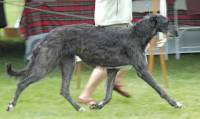 Deerhound Deerhound |
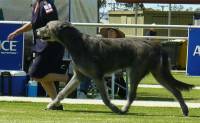 Irish Wolfhound Irish Wolfhound |
|
| Body | Curved topline and underline resembling the build of a Greyhound with a distinct arch or droop over the loin | Looking over the dog, the back is wider than a Greyhound through to the hips, with not as much arch over the loin |
| Hindquarters | Broad and powerful with great length from hips to hock | Long, strong, muscular and sound |
| Feet | Compact and well knuckled with strong nails | Round and moderately large with strong nails |
| Tail | Almost reaching the ground, the tail is thick at the root and tapers. Curved when moving but low-set and should never be lifted above the level of the back. Well covered with hair which may form a slight fringe. | Long and slightly curved, of moderate thickness and well covered with hair |
| Movement | Free and active with a long stride. Amazingly agile, capable of a double suspension gallop. | Easy and active. |
References and Further Reading
[1] 'Tyzack's Annual' Compiled by T. W.Tyzack and C.S.Turner Published by the Victorian Poultry and Kennel Club 1912 Printed by Bellamine Bros. Printers, 66-70 Flinders Lane Melbourne Importations Page 86 Stud Book Page 23
[2] Virginia Hawke, 'The History of Purebred Dogs in Australia' Deerhound published by OzDog Newspaper 1997 Page 122-3. John Lewington Irish Wolfhound Page 190.
[3] Catalogue of the First Exhibition of Sporting & Other Dogs, Thursday & Friday April 7 & 8, 1864 promoted by the Council of the Acclimatisation Society, printed in Melbourne by Mason & Firth, Printers, Flinders Lane West Page 15
[4] Robert Leighton "The Book of the Dog" published circa 1905 Subscriber's Edition, The Waverley Book Co. Ltd. Chapter XVI, Page 168
[5] W. Beilby 'The Dog in Australasia' published George Robertson & Company in 1897 Chapter on 'The Deerhound' Page 126
